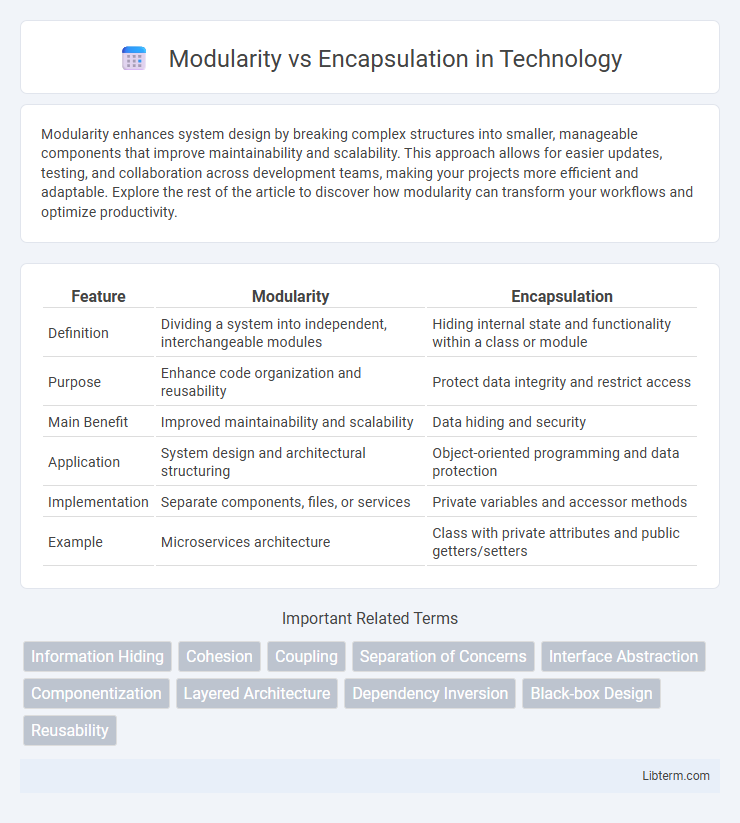Modularity enhances system design by breaking complex structures into smaller, manageable components that improve maintainability and scalability. This approach allows for easier updates, testing, and collaboration across development teams, making your projects more efficient and adaptable. Explore the rest of the article to discover how modularity can transform your workflows and optimize productivity.
Table of Comparison
| Feature | Modularity | Encapsulation |
|---|---|---|
| Definition | Dividing a system into independent, interchangeable modules | Hiding internal state and functionality within a class or module |
| Purpose | Enhance code organization and reusability | Protect data integrity and restrict access |
| Main Benefit | Improved maintainability and scalability | Data hiding and security |
| Application | System design and architectural structuring | Object-oriented programming and data protection |
| Implementation | Separate components, files, or services | Private variables and accessor methods |
| Example | Microservices architecture | Class with private attributes and public getters/setters |
Introduction to Modularity and Encapsulation
Modularity divides a software system into distinct, manageable components, each with a specific functionality to improve maintainability and scalability. Encapsulation restricts access to internal object details, exposing only necessary interfaces to enhance security and reduce complexity. Together, modularity and encapsulation enable robust software design by promoting separation of concerns and controlled interaction between components.
Defining Modularity in Software Design
Modularity in software design refers to the division of a system into distinct, self-contained components or modules, each responsible for a specific functionality. This approach enhances code maintainability, scalability, and reusability by allowing individual modules to be developed, tested, and updated independently. Effective modularity reduces complexity and improves collaboration among development teams by clearly defining module interfaces and dependencies.
Understanding Encapsulation Principles
Encapsulation principles center on bundling data and methods that operate on the data within a single unit, typically a class, to restrict direct access to some of the object's components. This ensures controlled interaction through public interfaces, enhancing data integrity and preventing unintended interference. Encapsulation fosters maintainable and secure code by hiding internal states while exposing only necessary functionalities.
Key Differences Between Modularity and Encapsulation
Modularity refers to the design principle of dividing a software system into distinct, independent modules that encapsulate specific functionality, enabling easier maintenance and scalability. Encapsulation is the object-oriented concept of restricting direct access to an object's data and methods, protecting the internal state and promoting data hiding. The key difference lies in modularity focusing on overall system organization into separate components, while encapsulation concentrates on safeguarding the internal details of individual objects.
Advantages of Modularity in System Architecture
Modularity in system architecture enhances scalability by allowing independent development and maintenance of components, leading to faster upgrades and reduced downtime. It improves fault isolation, enabling easier identification and resolution of issues without affecting the entire system. Reusability and clearer system organization result in more efficient resource utilization and streamlined collaboration among development teams.
Benefits of Encapsulation for Code Security
Encapsulation protects sensitive data by restricting direct access through controlled interfaces, reducing the risk of unauthorized modifications and data breaches. It ensures that internal object states are hidden, preventing external code from inadvertently corrupting or manipulating critical information. This security layer enhances code robustness and supports the enforcement of access controls within software systems.
Real-world Examples of Modularity and Encapsulation
Modularity is exemplified in automotive design where the engine, transmission, and chassis are developed as separate units that can be independently designed, tested, and replaced without affecting the entire system. Encapsulation is seen in smartphone software development, where applications hide their internal data structures and expose only necessary interfaces to interact with users or other apps, protecting data integrity. Both principles enhance maintainability and scalability but address different aspects of system organization and data protection.
When to Use Modularity vs Encapsulation
Modularity is ideal for breaking down complex software systems into independent, reusable components that improve maintainability and scalability. Encapsulation should be used to protect internal object state and enforce controlled access via well-defined interfaces, enhancing data security and integrity. Choose modularity when the goal is to manage system complexity at a macro level, and opt for encapsulation to safeguard object behavior within individual components.
Challenges in Implementing Modularity and Encapsulation
Challenges in implementing modularity include managing dependencies between modules and ensuring clear interfaces to prevent tight coupling, which can complicate maintenance and scalability. Encapsulation faces obstacles in controlling access to internal states while allowing necessary interactions, often requiring careful design of access modifiers and validation mechanisms. Both concepts demand a balance between isolation and communication within software components to achieve robust, maintainable systems.
Best Practices for Integrating Modularity and Encapsulation
Effective integration of modularity and encapsulation involves designing independent modules that expose clear interfaces while hiding internal details to enhance maintainability and scalability. Employing encapsulation within modular components prevents unintended interactions and supports easier debugging by localizing changes. Adhering to single responsibility and open/closed principles ensures that modules remain focused and extensible without compromising encapsulation boundaries.
Modularity Infographic

 libterm.com
libterm.com